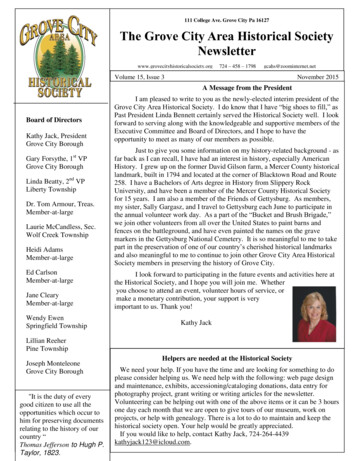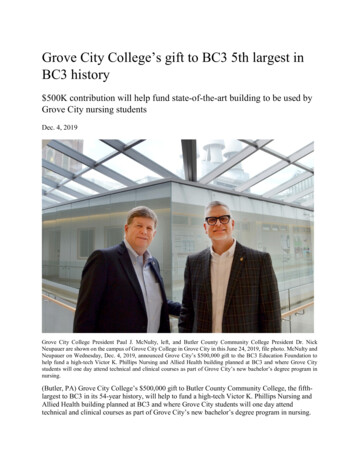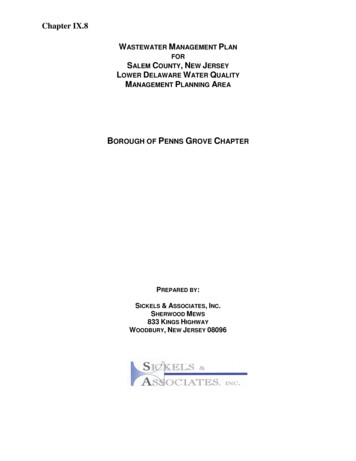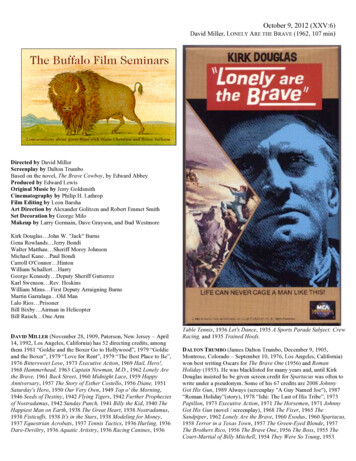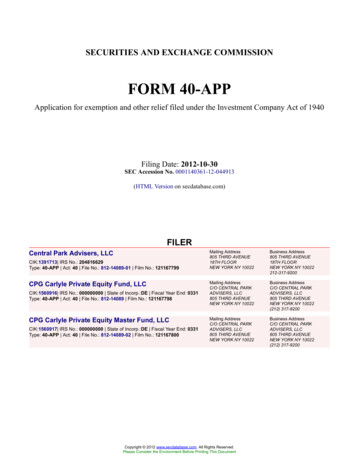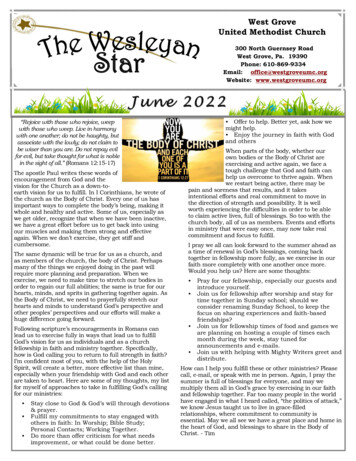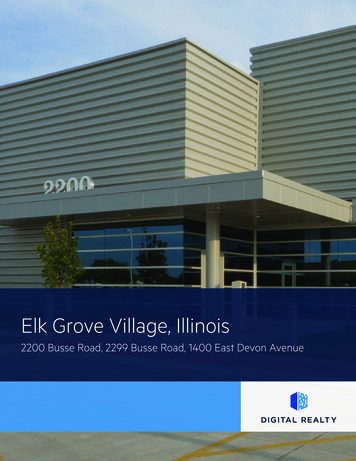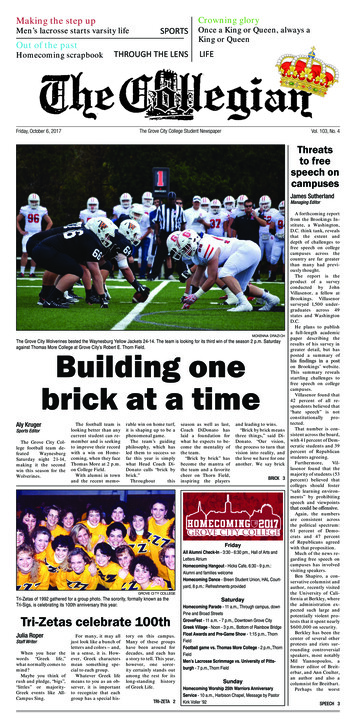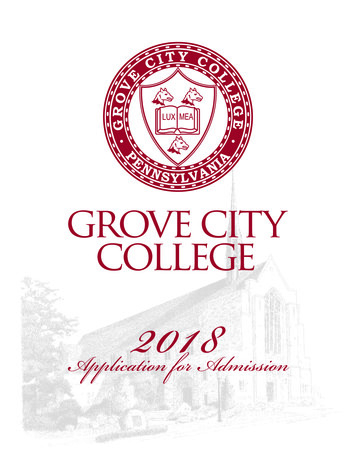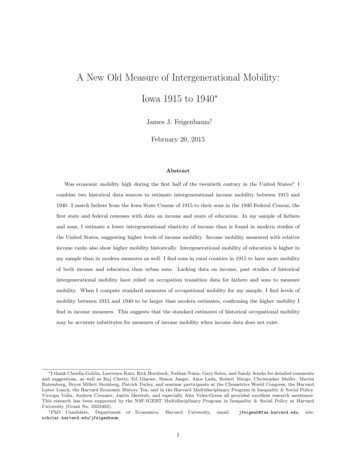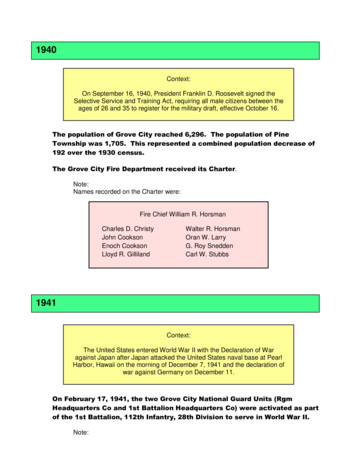
Transcription
1940Context:On September 16, 1940, President Franklin D. Roosevelt signed theSelective Service and Training Act, requiring all male citizens between theages of 26 and 35 to register for the military draft, effective October 16.The population of Grove City reached 6,296. The population of PineTownship was 1,705. This represented a combined population decrease of192 over the 1930 census.The Grove City Fire Department received its Charter.Note:Names recorded on the Charter were:Fire Chief William R. HorsmanCharles D. ChristyJohn CooksonEnoch CooksonLloyd R. GillilandWalter R. HorsmanOran W. LarryG. Roy SneddenCarl W. Stubbs1941Context:The United States entered World War II with the Declaration of Waragainst Japan after Japan attacked the United States naval base at PearlHarbor, Hawaii on the morning of December 7, 1941 and the declaration ofwar against Germany on December 11.On February 17, 1941, the two Grove City National Guard Units (RgmHeadquarters Co and 1st Battalion Headquarters Co) were activated as partof the 1st Battalion, 112th Infantry, 28th Division to serve in World War II.Note:
The 1st Battalion, 112th Infantry, 28th Division was involved in combat at Normandy,Hurtgen Forest, and in the Battle of the Bulge. The unit was nicknamed the "BloodyBucket" division by German forces because of its red keystone insignia. It was featuredin the film „When Trumpets Fade‟, a movie about the battle at Hurtgen Forest.The 28th Infantry Army National Guard Division was the oldest division-sized unit in thearmed forces of the United States. The division had been officially established in 1879and was re-designated the 28th Division in 1917. It is nicknamed the "KeystoneDivision," because it was formed from the Pennsylvania Army National Guard.In March, Grove City College began training sailors in its Naval TrainingSchool.Note:The Naval Training School at Grove City College was the first of the Navy's primary EEand RM training to be organized in the East. There were seven of these schoolsestablished in the United States.The school was authorized in early February 1942. Its commanding officer was Lt.Commander William F. Grogan. With the help of Dr. Weir C. Ketler, College President,and Russell P. Smith, educational director, Grogan the training program was organizedand under way in less than one month.On March 1st the first hundred RT2c reservists started training and on May 1st a Marinetraining detachment was authorized.Memorial Dormitory was converted into barracks to house the men. The collegegymnasium and athletic field were available to the enlisted men. Local facilities werealso used. The local community swimming pool was reserved for the men of the navalschool on Sundays. A local USO provided varied entertainment - dances, picnics,lounges, and reading rooms.Courses in mathematics and communications training for radar, sonar, and radio weretaught. Through classroom, laboratory, and shop instruction, the Navy's radiotechnicians received a thorough grounding in basic electrical principles, including radio,uhf and cathode-ray tubes.This photograph shows a group takingmeasurements on an amplifier.L. to R., back row:W8LWV; Marine Pvt. Merriam; W8RUJ,instructor.Front row:Marine Pvt. Mazzeo; W3JMO-W3JWL.
Shown are students measuring the impedanceof a telephone line.Standing is Instructor Smock, chief operatorWSAJ, owned and operated by the College;in the center are two Marine privates;Training also included other skills thatwould be needed by the sailors andmarines.This photograph shows a group beinginstructed to lash a hammock.Here is Lt.-Commander Grogan's description of the final month in the course as given atGrove City as published in QST magazine in November of 1942:The course in alternating currents includes a detailed study of the principles ofa.c., various series and parallel circuits, resonance, polyphase voltages andcurrents.The theory of the construction and operation of a.c. machinery, rectifiers andtransmission lines is taken up. A trip is taken through the local light and powerplant to study this machinery in actual operation. During the first three weeks, four hours per day are devoted to radio andelectrical experiments. There are experiments dealing with resonant circuits,tube characteristics, Class A, Band C amplifiers, frequency response oftransformers and amplifiers and many others. The well equipped collegeelectrical and radio laboratories are extensively used. In the electrical laboratorythere are all types of single and polyphase a.c. and d. c.machinery, transformersand a large central switchboard. The college owns a 1 kilowatt ham rig (W8NXW) and a 100-watt broadcaststation (WSAJ) on 1348 kc., also a complete Western Electric loading panel andline-test apparatus. The latter setup allows the men to test the frequencyresponse of from 1 to 60 miles of telephone line. Oscilloscopes, vacuum-tubevoltmeters, signal generators and beat frequency oscillators all aid in making theexperiments vivid and complete.The last portion of the third month is spent in receiver construction. When completed, these sets are tested with the 'scope and analyzers, To morefully explain the construction and theory, demonstrations are given on the RCAdynamic demonstrator in conjunction with the 'scope, signal generator and audiooscillator.
The Navy contract ended in 1945.The sailors who trained at the college left behind a nickname that remains to this day.The sailors began calling the snack bar the “Geedunk.” “Geedunk” is the nickname forthe snack bar on a ship. The snack bar at Grove City College is still referred to as theGeedunk.Vita: Francis “Mac” McKernonFrancis “Mac” McKernon graduated from the programand went on to become the Chief Radio Technician onthe aboard the USS Corry (DD-63) at Normandy.The USS Corry (with the destroyers USS Fitch (DD-462)and USS Hobson (DD-464) close by) led the Alliedassault force for the invasion at Normandy. The USSCorry was sunk in the battle on June 6, 1944.McKernon was rescued by a PT boat and taken to theUSS Fitch (DD-462).These pictures were taken byMcKernon in 1942, (fromMcKernon website)This photograph is labeled“Navy College at GroveCity, Pennsylvania”.This photograph shows McKernon‟sNavy Communications Class, April toJuly 1942.
Sailors and Marines betweenclasses July 1942. (Below)General Electric produced nine GE 45-Ton switcher "Off-Center Cab"locomotives with the Cooper Bessemer EN6 engine.Note:At this time, General Electric was not manufacturing diesel engines. It was primarilyusing General Motors and Alco diesel engines in its locomotives.Cooper-Bessemer engines were to become a primary interest of General Electric as itbecame interested in entering the locomotive business.In recognition of its services to the United States, a Victory Ship, the SSGrove City Victory, was named for Grove City College.Note:On March 17, 1945 construction was begun on VictoryShip Hull # 750 at the Permanente/ Kaiser Shipyard,Yard #2 in Richmond, California, It was a 6,000 hp (4.5MW) general cargo vessel.Victory ships were produced in large numbers to meet thecargo shipping needs of World War II.On April 28, 1945 this ship was launched as the SS GroveCity Victory. Hull Number 750; VC2-S-AP2/USAT.The drawing below illustrates a side view of a victory ship.
Cooper-Bessemer began a wartime production schedule producing dieselengines and locomotive engines.Note:Cooper-Bessemer had soldengines to several branches of themilitary before the war. During thewar, Cooper-Bessemer suppliedengines for military use,particularly for the Navy who usedthe C-B engines in their shipsincluding battleships. It alsoincreased its production oflocomotive engines.At the right is a photograph of aturbocharged version of the Cooper Bessemer Type LS marine engine.Cooper Bessemer was one of the earliest US users of turbo charging, which typicallyincreased engine output from 30% to 50%.In 1941, Cooper-Bessemer sales surpassed their pre-Depression level, jumped to an alltime high, and just two years later, they had more than tripled. At the peak of its wartimeproduction, Cooper-Bessemer had 4,337 employees working in round-the-clock shifts.(See 1929).Gordon Lefebvre was elected company president in 1943. Lefebvre, who had come tothe company from General Motors's Pontiac division, had a background in engineering.He had served as Cooper-Bessemer‟s vice-president and general manager. Thecompany was listed for the first time on the New York Stock Exchange in 1944.After the war, Cooper-Bessemer focused on its core business in the oil and natural gasindustries. Cooper-Bessemer became increasingly interested in selling its productsworldwide. It formed an international sales office and announced its first sales-servicebranch outside the United States, in Caracas, Venezuela, in 1945.Cooper-Bessemer received its first postwar orders from the Soviet Union. (See 1953)Grove City College built Lincoln Hall was in 1941.Note:Lincoln hall was named for President Lincoln.The building was a gift from the J. Howard pew family. J. Howard graduatedfrom Grove City College in 1900 and was a long time benefactor of the college.1942The McKay Carriage Company closed.
1943The following Grove City businesses were cited as operational byJoseph Riesenman’s in his history of northwestern Pennsylvania published in1943.CompanyBusinessThomas Flexible CouplingProducing Precision-Built EnginesG. A. Freyermuth & SonThe William BashlinCompanyFeed and Flour MillMontgomery BroomCompanyG. C. Broom CompanyGeorge J. Howe Company.Beauty-Clear MirrorCompany.Manufacturing Linemen's EquipmentManufacturing BroomsManufacturing BroomsProducing CoffeeManufacturing Mirrors1945Context:On Monday, August 6, 1945, the U.S. dropped the nuclear bomb "LittleBoy" on the city of Hiroshima, JapanOn August 9, the nuclear bomb, "Fat Man" was dropped on Nagasaki,Japan.Brenton B. Holter began transporting students in school busses.Note:Holter began by transporting coal by night and public school students during the day. Atthe same time the school business grew, he was developing a charter and tour busbusiness, Grove City Bus Lines.On February 18, 1957, Brenton B. Holter and Dallas L. Shull registered the name GroveOn18, 1957,Brenton B. 21,Holterand GroveWilbur CityD. FarrenregisterednameGrove CityCityFebruaryBus Lines.On November1961,Bus ld his interest to Dallas L. Shull. On November 21, 1961, GroveBrentonHolterlateras President.City Bus Lines, Inc. was incorporated with Brenton B. Holter as President.
In 1984, Holter separated the school bus business (incorporated as Brenton B. Holter,Inc. on October 15, 1984, with Karen H. Schell as President) from the coach business(Grove City Bus Lines). He sold Grove City Bus Lines and continued to operate theschool bus lines. On March 20, 1986, Grove City Bus Lines Company was incorporatedwith Robert V. Goebel as President. (former name listed as Grove City Bus Lines, Inc.)Upon his death in 1992, his daughter, Karen H. Schell, assumed the business.In 1999, Student Transportation of America, Inc. (STA) acquired Holter SchoolEnterprises, Inc. Student Transportation of America, Inc. was the second-largest privateprovider of school transportation and management services in the United States at thattime. STA registered the name Holter School Enterprises on July 9, 1999.The Grove City Youth Center opened.The P. Wall Manufacturing Company was operating in Grove City.Note:When P. Wall located in Grove City is uncertain. The McKay business had closed in1942. The P. Wall Mfg. Co. was not listed in Riesenman‟s 1943 history of northwesternPennsylvania. In 1949, P. Wall Mfg. Co. advertised its location as 214 Erie Street,Grove City, Pa. in Railway Age: Volume 127.The P. Wall company was established in 1864 by Patrick Wall in Pittsburgh. Earlyproducts included oil cans, blow torches, and plumber‟s furnaces. With the advent ofelectricity the company developed and began marketing electric soldering tools.P. Wall Manufacturing was the oldest manufacturer of blowtorches and fire pots in theUnited States. The company marketed products under the trade names Wall, Superior,and Dreadnaught.In the 1940s, the P. Wall Manufacturing Company began acquiring other companies.Among those was the Harmic Manufacturing Company acquired c1949. Harmic becamethe Harmic Division of the company. Its operations were moved to Grove City. On April6, 1950 The Harmic Corp, located on Erie Street, was incorporated in Pennsylvania.
They developed a complete line of soldering products that were manufactured in theGrove City plant at the old McKay building at 214 Erie Street.During the 1950s Alexander Shoenwald, Director of Research for the company, wasgranted a number of patents relating to soldering equipment and blowtorches. Shownare the patent drawings for a soldering iron and an “electric tool” that appears tp be ascrew driver. Both list Shoenwald as the inventor.Harry H. Sherman and Myer A. Silverman, Grove City, Pa., were also assignors to the P.Wall Mfg. Company who were granted patents during this time.In 1955, P. Wall acquired the Hommell Corp.,manufacturers of screwdrivers and bits,and moved their equipment and operations to GroveCity.On April 8, 1958 the Hommel Corp, Grove Citypatented a power operated screw driver. Shown isthe drawing for the screw driver submitted with thepatent application.In 1959, Hommel Corp. was sold to the Vermont Tap& Die Co. who moved the operation to Vermont.In 1960 E. G. Oppenheimer was the President of theWall Company; Alexander Schoenwald, Director of
Research; H. H. Sherman the Vice President. The company was conductingelectrothermic research. It employed a chemist, a physicist, an electrical engineer, ametallurgist and four technicians.The P. Wall Company eventually merged with the Lenk company (who also made smallblowtorchesIn 1966, all administrative and manufacturing operations were moved from Pennsylvaniato Kinston, NC. The company became known as the Wall Lenk Company.Charles H. Montgomery was murdered near St. Augustine, Florida.Note:Charles Montgomery was with the Montgomery Lumber Company. He maintained awinter home in Fort Lauderdale, Florida. On April 21, while on his way to his winterhome, Montgomery went missing after checking out of a hotel in Atlanta.His body was discovered under a small wooden bridge on April 28.Charles Allen, 20 years old, was arrested and confessed to the murder. According toAllen‟s confession, he was hitchhiking 20 miles south of Atlanta and Montgomery hadgiven him a ride The murder took place on a deserted road near Starke, Florida. Allenconfessed to shooting Montgomery in the head and hiding the body under the bridge.1946Broad Street as it appeared in 1946.Henry Limberg Sr. and his son, Henry Jr., started the Henry T. LimbergCompany specializing in refrigeration and installation of equipment.Note:
Henry Limberg Sr., a mechanical engineer, came to Grove City from Pittsburgh to designand build the Wendell August Plant. He was E. J. Fithian‟s brother-in-law. After theforge was completed, he remained in Grove City working on projects for Fithian.In 1946, he established the Henry T, Limberg Company. On March 1, 1968, the HenryT. Limberg Company was incorporated with William Limberg as President and RobertLimberg as Vice President. They became the third generation of the family to operatethe business.In 1980, The Henry T. Limberg Company bought the firm Commercial ApplianceContracts of Monroeville, Pa. enlarging their business to include all types of kitchenequipment.George A. Stewart purchased James H. Black’s furniture business.Note:The James A. Black firm had been established in 1851 as an undertaking andfurniture business. (See 1851)Stewart successfully operated the business until he retired in the 1970s.Clarence “Jock” Filer and his nephews, Gene and Joseph and Robert L.,established Filer Auto Body.Note:When Jock retired, Robert left the business. In 1986, Gene also left the business.Leaving Joseph to continue the business. His son, Mark joined him in the business.As the business increased, Filer Auto Body moved into a new building at 113Breckenridge Street.On May 12, 1997, Filer Auto Body, Inc. was incorporated with Mark A. Filer as Presidentand Theresa J, Stutz as Treasurer.Cliff Sonntag opened a Sunoco Gas Station.Note:This station remained in business for 29 years until 1975 when he retired fromthe service station to dairy farm full time.1947In 1947, F. H. Hall began F. H. Hall Linemen's Supplies, a mail-order businessselling lineman’s supplies, in the basement of his Chestnut Street home.Note:Hall began publishing a 12-page catalog listing boots, gloves, hand tools, and othersupplies.
The business grew, moving to Erie Street and then into a new building on Gasper &Sandy Lake roads in 1953.In 1972, his son, Jack "Skinny" Hall, formed a similarcompany. He began mailing catalogues to everycompany related to the utility industry within severalstates.After the death of his father, Skinny operatedboth businesses with his mother (Evelyn) and hissons (Rick and Jim) until Evelyn retired in 1976.In 1982, Skinny merged the two companies into Hall'sSafety Equipment, Inc.In 1986, Rick assumed the presidency.In 1993, a new warehouse and office complex was completed and in 2004 another 5,000square feet were added. In 1994, a specialized computer system was designed andwas incorporated for inventory and sales management. In 2005, Jim joined the familybusiness as Advertising Manager.Cooper-Bessemer introduced the GMW family of integral two-stroke cycle ICengines for use in the natural gas pipeline industry.Note:These models utilized innovative "turboflow" high-compression technologydeveloped by Cooper-Bessemer inc1945. Five models of these engineswere manufactured over a period ofnearly 20 years to 1965.The engines were capable ofproducing 2,500 horsepower. Theycould be shipped in one assembledunit.In 1947 Cooper-Bessemer held an Open House.Note:On November 11 and 12 (?)Cooper-Bessemer held an OpenHouse. This illustration shows thecover of the booklet that wasdistributed. It features a view of theplant as it appeared in 1947viewedfrom the railroad side of the facilities.The Grove City Christian Science Society was organized.
The Grove City Optimist Club was established.Note:The club centered on local youth projects.The Optimist Club was responsible for initiating Grove City‟s Midget Football and BiddyBasketball programs.George Junior Republic built a new educational facility, the BarnesSchool.The Larkfield Drive In Theater was established.Note:On May 15, 1947 the nameLarkfield Drive In Theater wasregistered by Chester andLavonne Demarsh.The theater was located on theGrove City – Harrisville Road(PA Rt 58) and had a carcapacity of 300.This Google image shows asatellite image of the locationin 2011.From 1975 to 1980 the business was owned by the Cinemette Corporation of America.The business closed in 1980.1948Context:The peacetime military draft began with passage of the Selective ServiceAct. The new law required all men, ages 18 to 26, to register
The Grove City Lions Club was chartered in May 1948.Note:Cecil C. Harper was elected the first King Lion. The Lions Club became an activeongoing service in Grove City supporting numerous projects over the years.Grove City celebrated its sesqui-centennial.Note:Activities included a beard growing contest, araffle of a Lincoln automobile, a parade withfloats, and the Crowning of a Queen, BonnieSchreffler.The cover of the sesqui-centennial,Souvenir program, dated August22-28, 1948, is shown at the right.The Grove City Creamery closed ending an era in for local dairy farming.The Grove City Highland Band was organized.Note:The Highland Band had its beginnings at Dad‟s Restaurant with a group discussion overcoffee. While discussing bagpipes several of the participants agreed to attempt toorganize a drum and bagpipe band. They agreed to meet at the National Guard Armoryon December 7, 1948 to pursue the idea.That meeting led to a second meeting on December 15 during which the band wasformed. Dr. Harold Barnes raised money for the band.The band‟s first publicappearance was on MemorialDay in 1949. The bandmarched in full kilt attire.This photograph was taken onMemorial Day Parade in1958.The Highland appeared inparades and at eventsthroughout the area fordecades.The Grove City Business and Professional Women’s Club was organized.
1949The Grove City Fire Department purchased a 1949 American LaFrance FireTruck.Note:The truck was housed at Station No. 1 seen in the background o\f this photograph.The fire truck is owned by Bob Zercher; photographed by: Adam AlbertiThe first commercial ductile iron castings were made at Cooper-Bessemer onFebruary 4, 1949.Note:This project had been instituted by Executive Vice President Lawrence Williams andsupervised by Tom Eagan. The development group had been established to developand improve foundry-casting technologies.The castings included Keel blocks, diesel engine parts, a pressure cylinder, an 8-in,cube, and two cylinder liners.In 1973, this achievement was recognized at the 25th anniversary meeting at the 1973AFS Casting Congress.On January 27, 1949, the Grove City Kiwanis Club was established as a nonprofit corporation.
Note:Another source states the club was established in 1943.The Kiwanis was active in the community sponsoring events and raising money forvarious community activities.In 2009, the Kiwanis was dissolved.
Grove City Victory, was named for Grove City College. Note: On March 17, 1945 construction was begun on Victory Ship Hull # 750 at the Permanente/ Kaiser Shipyard, MW) general cargo vessel. Victory ships were produced in large numbers to meet the cargo shipping needs of World War II. On April 28, 1945 this ship was launched as the SS Grove
